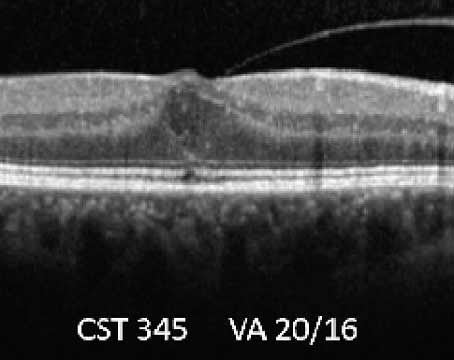Researchers compared visual field progression between the two arms of the Treatment of Advanced Glaucoma Study (TAGS), as part of a post hoc analysis of VF data from a two-arm multicenter randomized controlled clinical trial.
A total of 453 patients with newly diagnosed advanced open-angle glaucoma in at least one eye from 27 centers in the United Kingdom were randomized to either trabeculectomy (n=227) or medications in their index eye (n=226) and followed-up for two years with two 24-2 VF tests at baseline, four, 12 and 24 months.
Average difference in rate of progression (RoP) was analyzed using a hierarchical Bayesian model. Time for each eye to progress from baseline beyond specific cutoffs (0.5, 1, 1.5 and 2 dB) was compared using survival analysis.
A total of 211 eyes in the trabeculectomy-first arm and 203 eyes in the medications-first arm were analyzed. Here are some of the findings:
- The average RoPs (estimate [95 percent credible intervals]) were:
— -0.59 (-0.88 to -0.31) dB/year in the medications-first arm and -0.40 (-0.67 to -0.13) dB/year in the trabeculectomy-first arm.
— The difference wasn’t significant (Bayesian p=0.353).
— More eyes progressed in the medications-first arm: ≥0.5 dB (p=0.001), ≥1dB (p=0.014), ≥1.5dB (p=0.071) and ≥2dB (p=0.061).
Researchers found no significant difference between the two arms in TAGS in the average RoP at two years.
Am J Ophthalmol 2022. Oct 10. [Epub ahead of print].
Montesano G, Ometto G, King A, et al.
Vascular Density in DR
Investigators assessed choroidal vascularity by diabetic retinopathy stage using the choroidal vascular density (CVD) obtained from swept-source optical coherence tomography en face images.
This prospective, cross-sectional, multicenter study included patients from Niigata City General Hospital and Saiseikai Niigata Hospital between October 2016 and October 2017. CVD was obtained by binarizing SS-OCT en face images.
Patients were allocated to the healthy control (n=28), no DR (n=23), nonproliferative DR without diabetic macular edema (n=50), NPDR+DME (n=38), and proliferative diabetic retinopathy or any previous treatment with panretinal photocoagulation (n=26) groups. Here are some of the findings:
- Investigation of the choriocapillaris slab level indicated the no-DR group had significantly high CVD values (p<0.05) and PDR groups had significantly low CVD values (p<0.01).
- Investigation of the large choroidal vessel level indicated that the NPDR+DME and PDR groups had significantly lower CVD values than the control group (p<0.05 and p<0.01, respectively).
Retina 2022. Oct 10. [Epub ahead of print].
Nakano H, Hasebe H, Murakami K, et al.
Biomarkers for Wet AMD
Researchers identified optical coherence tomography biomarkers, including thin and thick double layer signs (DLS) for progression from intermediate AMD (iAMD) to exudative macular neovascularization (MNV) over 24 months, as part of a retrospective cohort study conducted at Retina Consultants of Texas.
A total of 458 eyes of 458 subjects with iAMD in at least one eye with 24 months of follow-up data were included.
The following biomarkers were assessed at baseline: high central drusen volume (≥0.03 mm3); intraretinal hyperreflective foci (IHRF); subretinal drusenoid deposits; hyporeflective drusen cores; thick/thin DLS; and central choroidal thickness.
Here are some of the findings from the analysis:
- During follow-up, 18.1 percent (83/458) of eyes with iAMD progressed to exudative MNV.
- Thick DLS, IHRF and fellow eye exudative MNV were found to be independent predictors for the development of exudative MNV within two years.
- Baseline frequencies, odds ratios, 95 percent confidence intervals and p-values for these biomarkers were as follows:
— thick DLS (9.6 percent: 4.339; CI, 2.178 to 8.644; p<0.001);
— IHRF (36 percent: 2.340; CI, 1.396 to 3.922; p=0.001); and
— fellow eye exudative MNV (35.8 percent: 1.694; CI, 1.012 to 2.837; p=0.045).
Researchers determined thick DLS, IHRF and fellow-eye exudative macular neovascularization were associated with an increased risk of progression from iAMD to exudative MNV.
Am J Ophthalmol 2022; Oct 10. [Epub ahead of print].
Wakatsuki Y, Hirabayashi K, Yu HJ, et al.
This article has no commercial sponsorship.




